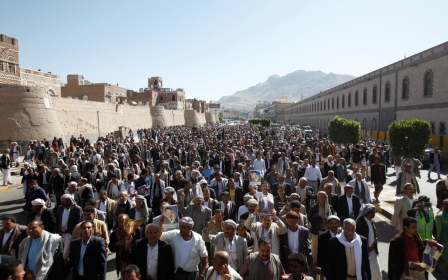Iran sends warships to Yemen coast after US attack on Houthis
Iran sent two warships to the Gulf of Aden on Thursday, the semi-official Tasnim news agency reported, establishing a military presence in waters off Yemen where the US military launched cruise missile strikes on areas controlled by Iran-backed Houthi forces.
"Iran's Alvand and Bushehr warships have been dispatched to the Gulf of Aden to protect trade vessels," Tasnim reported. The Alvand and Bushehr are both destroyers.
Saudi Arabia accuses Tehran of providing support to the Houthi political movement, a charge it denies.
Tasnim said the Iranian ships will patrol the Gulf of Aden, south of Yemen, which is one of the world's most important shipping routes.
The announcement comes hours after the US said it had fired cruise missiles at three Houthi-contolled radar stations after anti-ship missiles were fired at a US Navy destroyer.
The missile launches from the USS Nitze on Thursday morning mark the first time the US had directly attacked the Houthi rebels in Yemen.
“These limited self-defence strikes were conducted to protect our personnel, our ships and our freedom of navigation in this important maritime passageway,” the US defence department said. “The US will respond to any further threat to our ships and commercial traffic."
It added: “Initial assessments show the sites were destroyed.”
The US strike came after a second missile launch from rebel-held territory in Yemen had targeted a US destroyer, a Pentagon official said on Wednesday.
However, Houthi rebels issued a statement denying that they had fired a missile at the US vessel.
"Those claims are baseless," the rebel-controlled Saba news agency quoted a military official as saying.
"Such claims aim to create false justifications to step up attacks and to cover up for the continuous crimes committed by the (coalition) aggression against the Yemeni people."
Wednesday's attack involved a "coastal defence cruise missile" fired from a Houthi-controlled area south of al-Hudaida, the US official said.
The USS Mason used countermeasures after detecting the missile at about 6pm local time on Wednesday.
"It is unclear if the countermeasures caused the missile to hit the water, or if it would have hit the water on its own," said the official.
The ship was not hit.
On Sunday, two missiles fired from rebel-held territory in Yemen fell short of the Mason as it patrolled the Red Sea off the coast of the war-torn country.
Both missiles hit the water before reaching the ship and no one was injured in that incident, officials said.
On Monday, the Saudi-led coalition accused the rebels of firing a ballistic missile towards the southwestern Saudi city of Taif, hundreds of kilometres from the Yemeni border.
The missile was one of two that the coalition intercepted on Sunday - the other was launched toward Marib, east of Yemen's rebel-held capital Sanaa.
The incidents come after the United Arab Emirates said last Wednesday that Yemeni rebels struck a "civilian" vessel in the strategic Bab al-Mandab waterway, wounding crewmen. Rebels did claim that attack, which was carried out on 1 October.
The UAE is a key member of a Saudi-led coalition that has been pounding Yemen since March of last year.
Coalition warships have imposed a naval blockade on rebel-held ports along Yemen's Red Sea coast allowing in only UN-approved aid shipments.
Also, Houthi rebels fired a missile at the main Saudi air base used by the Arab coalition in its bombing campaign but it was intercepted, the coalition said on Wednesday.
It was the second such missile launch since a coalition air strike killed more than 140 people attending a wake in Sanaa on Saturday, prompting threats of revenge.
Air defence forces "intercepted a ballistic missile, launched by the Houthi militias toward the city of Khamis Mushait and destroyed it without any damage", a coalition statement said.
Khamis Mushait is home to the air base that has been at the forefront of the coalition bombing campaign against Houthi rebels and their allies.
It is about 100km from the Yemeni border.
Middle East Eye propose une couverture et une analyse indépendantes et incomparables du Moyen-Orient, de l’Afrique du Nord et d’autres régions du monde. Pour en savoir plus sur la reprise de ce contenu et les frais qui s’appliquent, veuillez remplir ce formulaire [en anglais]. Pour en savoir plus sur MEE, cliquez ici [en anglais].





